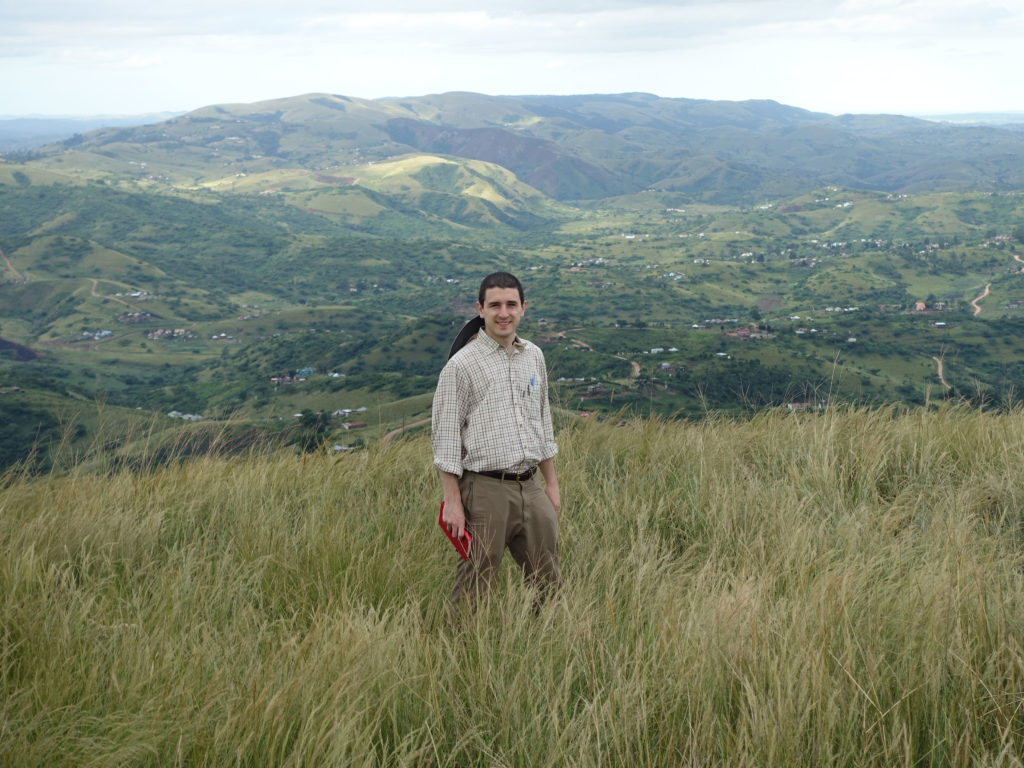
Every collector has a moment that first connected them with their chosen area of interest. My passion for stamp collecting and philately is connected to a 20-minute geography lesson at school using worldwide post-age stamps in the autumn of 1993. Holding so many different tiny, seemingly weightless pieces of other countries in the palm of my hand captivated me completely. That moment at age seven launched me on a collecting path which continues to this day. Over the years, I have collected and studied many different philatelic areas, at-tended hundreds of philatelic exhibitions large and small in over a dozen countries, worked on staff at the Smithsonian Institution’s National Postal Museum, won election to the American Philatelic Society’s Board of Directors, represented the Royal Philatelic Society London in the USA and most importantly developed many wonderful friendships along the way with fellow collectors. To say that a 20-minute geography lesson all those years ago changed my life would not be an understatement.
If the lightning of collecting inspiration had only struck me once, I would consider myself to be quite blessed but on 23rd August 1997, it struck me a second time. On that day, my family had just arrived in London for our very first trip overseas. As usual when coming from the US, we had taken an overnight flight and my younger siblings along with my parents were feeling the effects of jetlag. As we checked into our hotel for everyone to take a nap, I was bursting with excitement to explore this wonderful new city. After all, I had just arrived in the birthplace of the postage stamp and so much more, how could I possibly now go to sleep! After pleading with my parents to let me go walk around, they relented and sent me to the front desk to get a map. We synchronised our watches and set a time for me to meet them back at the hotel. Looking back, I give my parents a lot of credit for the confidence and trust they had in their 11-year-old son to make his way around London by himself.
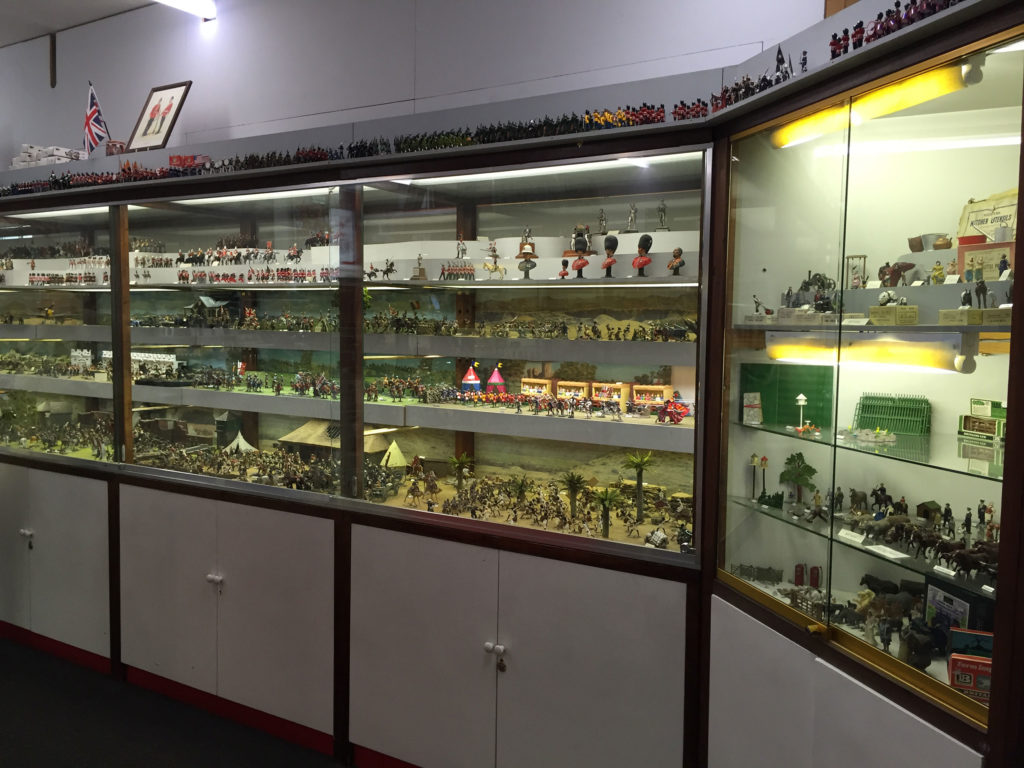
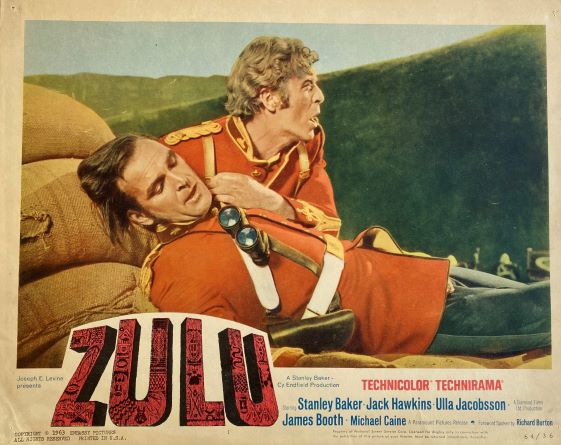
My first stop was Buckingham Palace as it was the closest major landmark to our hotel. After spending some time looking through the gates and around the Victoria Memorial, I started down Birdcage Walk towards the Palace of Westminster. Very soon I noticed a sign for the Guards Museum and their gift shop – The Guards Toy Soldier Centre. Since the shop was just a few metres off the road, I figured why not look inside? As I entered, I was stunned to see wall-to-wall displays filled with dioramas composed of thousands of hand-painted toy soldiers. They had a cavalry charge from the Battle of Waterloo, Allied forces from World War II fighting German troops through hedgerow country, Union and Confederate soldiers running across an open field in a scene from the American Civil War and a 10-foot long Trooping the Colour diorama with a 54mm-tall Queen Elizabeth II looking on. As I walked around the room in awe of the scenes around me, I came across one display that instantly captured my attention – the Anglo-Zulu War. I remember being instantly drawn to the bright red tunics of the British soldiers and the magnificent Zulu warriors with their large colourful shields and spears all positioned in the display in close contact fighting. After examining each figure in this display, I went to the front counter and asked for more information about the Anglo-Zulu War. Looking back I had clearly been deprived in my 11 years on this earth as I had never heard of the Battle of Rorke’s Drift or seen the movie Zulu featuring Michael Caine and Stanley Baker, nor read anything about the Zulu victory at the Battle of iSandlwana! The gentleman at the counter walked over to the display with me and began weaving a dramatic story of the whole campaign.
After he finished the story, I looked down at my watch and realised that I was on the edge of being late for my rendezvous back at the hotel with my family. I thanked my new teacher and promised I would return. For the following week, in the nooks and crannies of our busy touring schedule, I managed to return to that shop every single day for at least an hour. During my follow-on visits, I was trying to decide which military campaign interested me the most to both recreate with a toy solider display of my own and begin collecting postal history items (remember I was a philatelist first!) connected to that campaign. Across the week I studied every single figure on display, but my interest kept returning to the Anglo-Zulu War display. I found it fascinating for many reasons – from my point of view it was obscure in comparison to the Battle of Waterloo or World War II. I wanted to become knowledgeable about something that most people did not know about. I liked the opportunity to explore something without a direct American connection as my fellow countrymen did not participate in the conflict. I had a great interest in the American Revolutionary War and immediately felt a connection with the Zulu side, fighting the British as my American ancestors had. As I would go on to learn, the two conflicts fought a century apart in very different parts of the world were not as analogous as I thought during that week of visits to the shop, but it was part of my entry point to that area of history.
The shop owners basically adopted me during that week and were tremendously accommodating considering I was only able to buy four figures by the end of the trip – two British soldiers and two Zulu warriors. On the flight home as I admired he four figures, I laid out my plan for diving deeper into the Anglo-Zulu War:
1. See the movie Zulu
2. Buy and read books about the conflict
3. Acquire more toy soldiers to build full representative diorama of the war
4. Find and begin collecting Anglo-Zulu War philately
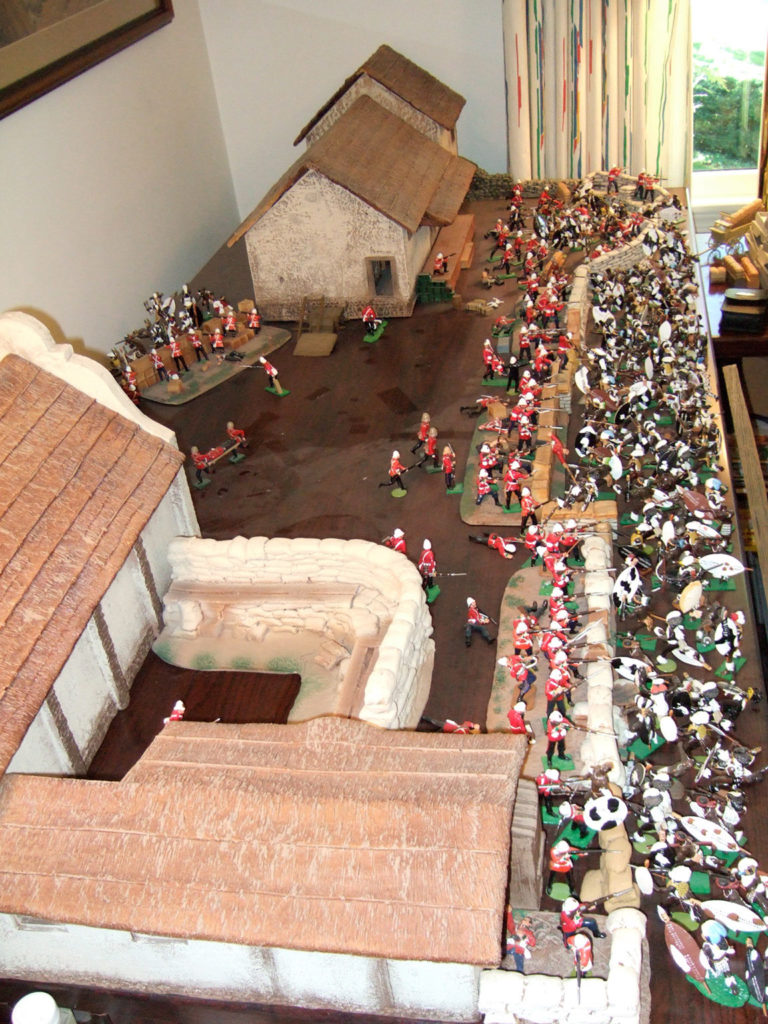
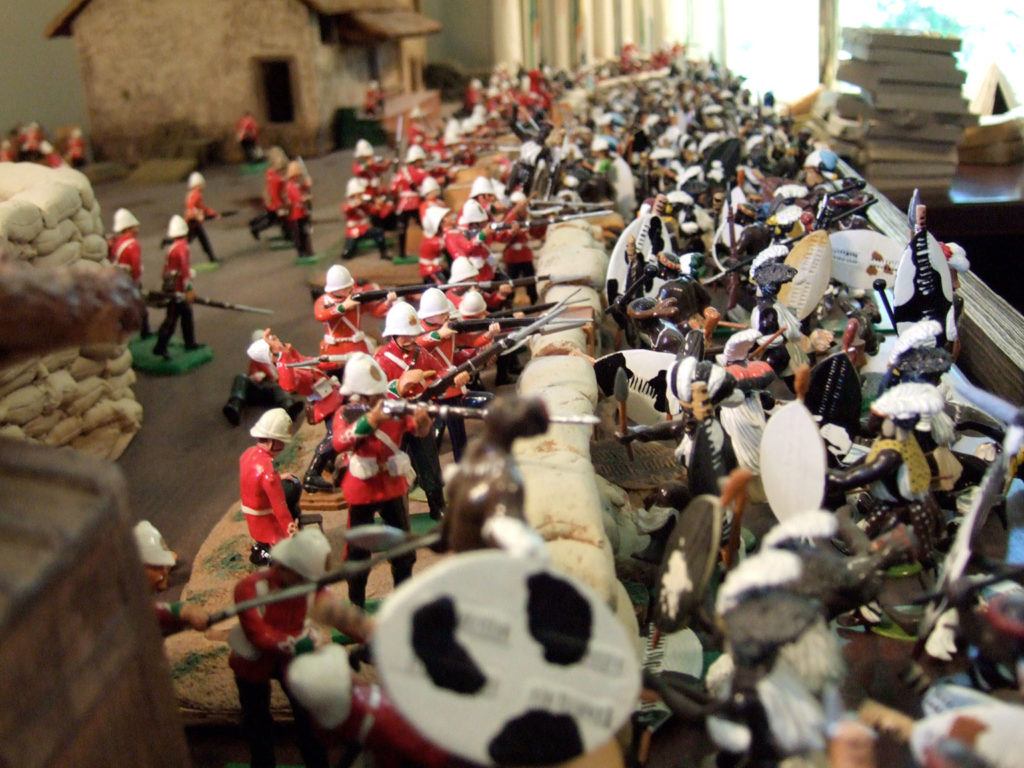
Alex’s toy soldier collection-display circa 2007
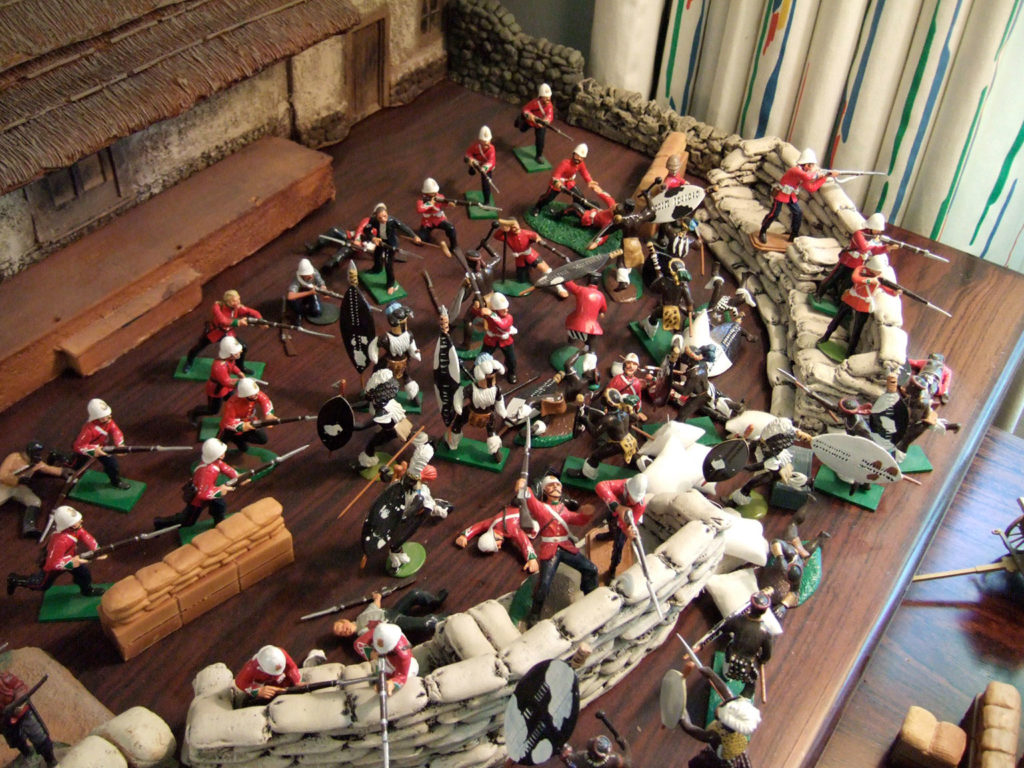
As I would learn over the next ten years, the first three items on my list would be considerably easier to accomplish than the fourth.
Within a week of my return to the States, I saw Zulu and began acquiring books to build up my knowledge. My library began, as many do, with Washing of the Spears by Donald Morris. Several Osprey titles by historian and author Ian Knight started to fill my shelves also, followed by his Brave Men’s Blood: The Epic of the Zulu War, 1879 and Nothing Remains but to Fight: The Defense of Rorke’s Drift, 1879. My third goal, to build my own Anglo-Zulu War toy soldier collection and display, began to pick up steam with all my extra spending money plowed into buying additional figures, scenery elements and other accessories.
My fourth goal – the one most connected to my original collecting passion – proved instantly difficult. The realisation that I was living in the wrong country to begin a deep focus on Anglo-Zulu war philately probably began in mid-1998, as I encountered the nth dealer at the nth stamp show I attended since returning from London asking if I meant Boer War when I had asked for Zulu War material. Though I would keep searching, it would be ten years before I held a piece of mail sent by a British soldier during the war in my hands.
In 2005, while a first-year university student in Washington, DC, I was fortunate to be recruited to join the staff of the Smithsonian National Postal Museum. Over the next five years, I gained experience working with different departments at the museum and exploring a diverse range of artefacts, all related to the history of postal systems. Before then, like most philatelists, I viewed stamps, envelopes, and letters as the most important types of artefacts to illustrate this history. Seeing non-philatelic artefacts in the collection ranging from postal carrier uniforms, vehicles, photographs, flags, posters, newspapers, badges, paintings, furniture and weapons convinced me that the ideal way to illustrate a historical narrative is through a multi-category collection of artefacts. All of this led me to think that maybe one day I could collect British and Zulu weapons, uniforms, military medals, period newspapers and other significant artefacts that would showcase all aspects of the Anglo-Zulu War and its participants. Though fun to daydream about it at the time, as of 2007 I still had not even found a piece of Anglo-Zulu War postal history for sale to start my collection.

Everything changed in early 2008, when I met a British dealer at a national exhibition in the United States. In his inventory were two envelopes sent by a British officer from Zululand during the 1879 campaign. Of course, I bought them and during the transaction I asked the dealer for advice on finding more. He explained that most collectors of this type of material live in the UK and South Africa, so he encouraged me to take a trip across the pond to explore further. I took the advice to heart and with university graduation just a few months away, I began planning my first solo Anglo-Zulu War collecting trip to the UK. I set my sights on a week in February 2009 where two different philatelic exhibitions would be taking place in London. On my very first day at Stampex, I had the good fortune to meet long-time dealer and auctioneer Ian Shapiro (now a Senior Specialist at Spink). Ian was born and reared in South Africa and shared my passion for the Anglo-Zulu War. My first collecting trip to the UK was a success on multiple fronts, including the purchase of more items for my postal history collection related to the war and the initiation of a series of new collector/dealer contacts.
Before the year was finished, I made two more trips back to the UK followed by additional visits in 2010. During these subsequent trips, I met other philatelic dealers and auction firms that specialised in related areas to my Anglo-Zulu interest. Additionally, during these follow-on visits, Ian made two significant contributions to my collecting journey. First, he introduced me to a wide range of other collecting events in the UK including ephemera fairs, book fairs, photograph collector events and art/antique exhibitions.

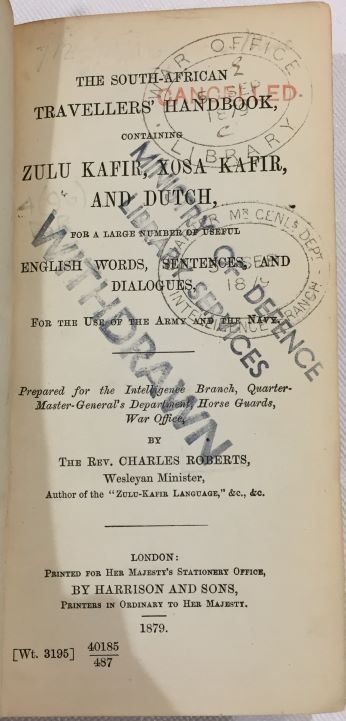
First non-philatelic artefact added to the collection – Zulu-English dictionary published in February 1879.
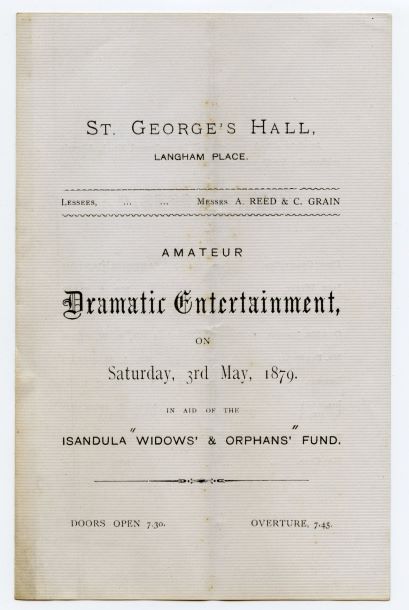
Though it seems obvious now, it was not clear how best to engage other collecting areas to learn about them and to begin finding the types of artefacts I was looking for. I had spent most of my life learning, experiencing, and engaging with the philatelic world; beginning to collect in totally different categories was far from intuitive. Ian proved to be the perfect teacher and guide. The second contribution Ian made was to give me that thoughtful push over the proverbial ledge so I would begin seriously collecting the Anglo-Zulu War outside of philately.
It all started with a book. On one of my trips, Ian offered me an 1879 pocket dictionary containing Zulu, Xhosa and Dutch “words, sentences and dialogues” translated to English and prepared by the Intelligence Branch of the War Office “For the use of the Army and the Navy.” The exact copy he offered me was the official War Office Library copy which had been deaccessioned in the 20th century. I initially could not comprehend the seemingly high price. It was many, many times more than I had ever paid for a book or anything outside of the philatelic arena. As I examined the book and simultaneously agonised over the cost, Ian said that in order to build a great collection for my area of interest it would be essential to seek out important items that illustrate other aspects of the history beyond what philatelic artefacts could. As to the cost, he pointed out that if this had been a piece of postal history related to the Anglo-Zulu War, I would have paid the price and not thought twice about it. He was right on both fronts and so I bought the dictionary.
With that purchase the floodgates had now truly been opened. Over the next five or so years, I began seeking out everything I could with a connection to the Anglo-Zulu War across as many different collecting areas as I could access. Through the ephemera fairs, I found 1879 charity pamphlets for events raising money to aid the “widows and orphans” of soldiers killed in the war. In the art and antiques world, I found original period chromolithograph prints and paintings executed by participants of the campaign. Additional antique items included a silver inkwell in the form of a Zulu warrior.
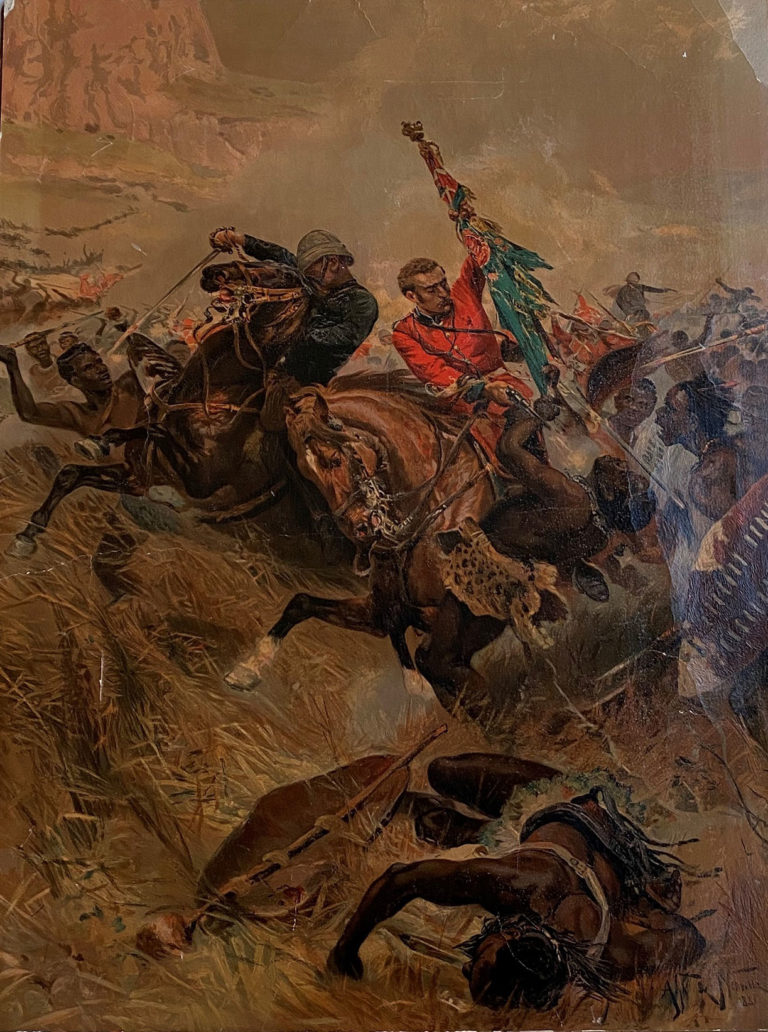
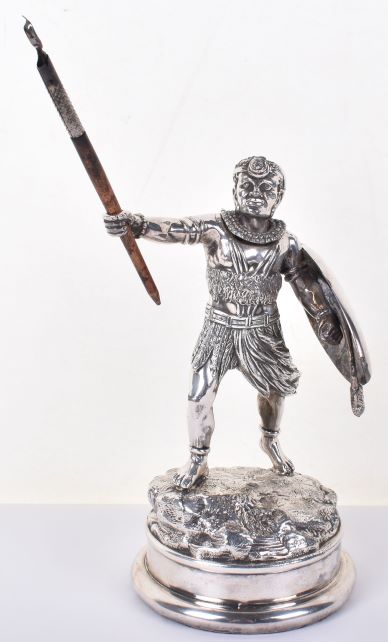
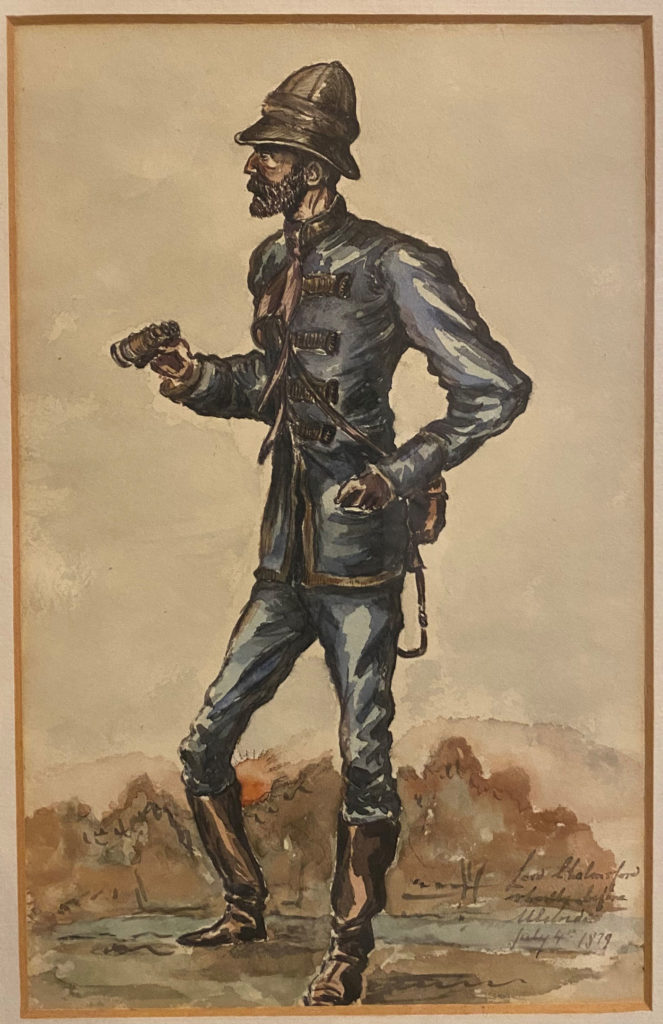
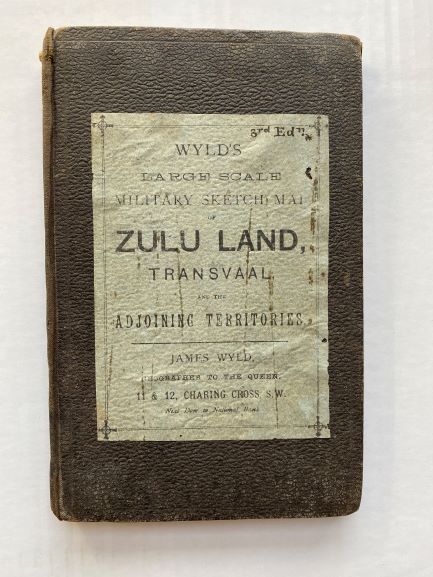
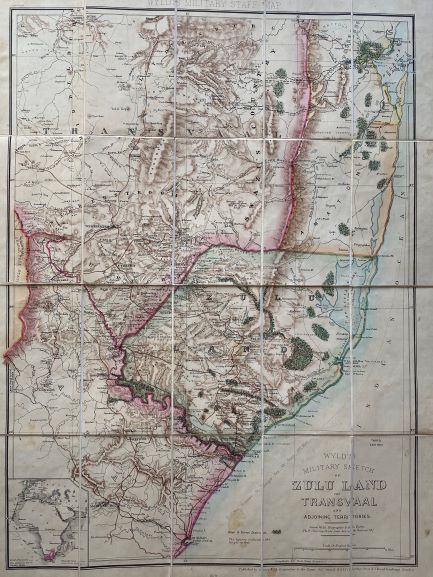




All the exploration of other collecting fields did not distract me from my original goal – to find postal history-related artefacts. To my surprise, the place I thought I would eventually find the most items – the traditional philatelic dealer and auction circuit – ended up being a minor source overall. Counterintuitively, by engaging a wide swath of other collecting areas outside of philately, I ended up finding and acquiring some of my best postal history artefacts through non-philatelic sources. Some highlights include letters sent during the campaign by Lieutenant John Chard, VC and Lieutenant Gonville Bromhead, VC – to be portrayed 84 years after their exploits at Rorke’s Drift by Stanley Baker and Michael Caine in ZULU; a very rare letter signed by the Zulu King Cetshwayo in 1882; illustrated envelopes featuring Anglo-Zulu War themes; and a January 1879 Natal newspaper sent through the mails to Britain containing some of the earliest local reporting from the campaign’s beginning stages.
My engagement with the map-collecting world yielded a series of 1870s-1880s maps of Natal and Zululand including a map prepared for British officers headed to the campaign in mid-1879. The antique photograph arena included original period pictures of Zululand, Zulu homesteads and prominent Zulu figures. The military medals-collecting world helped me reunite the campaign medal of an officer of the 24th Regiment with his original journals and letters that I acquired from his descendants. Since the Anglo-Zulu War is a military history topic, the militaria collecting field has been particularly helpful from original British military uniforms and related kit to firearms related to the campaign.







By 2015, after several years of successful collecting, I realised that the perspective most lacking in my collection was that of the Zulu. This realisation led me to finally meet the person who had shaped my knowledge of the Anglo-Zulu War the most since the age of 11, author and historian Ian Knight. In 2011, Ian published Zulu Rising: The Epic Story of iSandlwana and Rorke’s Drift (still available in paperback and a must-read for anyone interested in this period of history). This book is easily the most in-depth and comprehensive narrative of the people and events leading up to and through the Anglo-Zulu War. Most importantly, Ian goes beyond any book before it by incorporating the perspectives, records, and available oral histories of both the colonial and Zulu sides of the conflict. Meeting Ian irrevocably altered my journey for the better as he convinced me to finally come to South Africa and see Zululand with my own eyes. Ian has led battlefield and Zulu cultural tours for decades and in March 2017, almost 20 years after the start of my interest in this area of history began, I finally touched down in KwaZulu-Natal, South Africa.
My experience in Zululand changed my whole perspective from just being focused on the history of a brief few years in the 19th century to being fully interested in the history, heritage and culture of the Zulu people from before the 1870s and all the way to the present day. To date, I have made three trips to Zululand with a fourth trip unfortunately canceled in March 2020 as the COVID-19 pandemic picked up. I am grateful for the people I have met and the perspectives they have shared with me during these trips, including battlefield tour guide Lindizwe Ngobese (affectionately known as Dalton). He is the great-grandson of Mehlokazulu, who led several companies of the Zulu Army’s Ingobamakhosi Regiment, which formed the left horn of the Zulu forces at the Battle of iSandlwana. In 2019, for the 140th Anniversary of the Anglo-Zulu War, I joined the British delegation (as their token American) to participate in the official commemoration events presided over by the current Zulu King Goodwill Zwelithini kaBhekuzulu (the great-great grandson of King Cetshwayo kaMpande). All these experiences dramatically shifted my knowledge acquisition and collecting priorities to Zulu history, culture, and artefacts from the past to present-day.




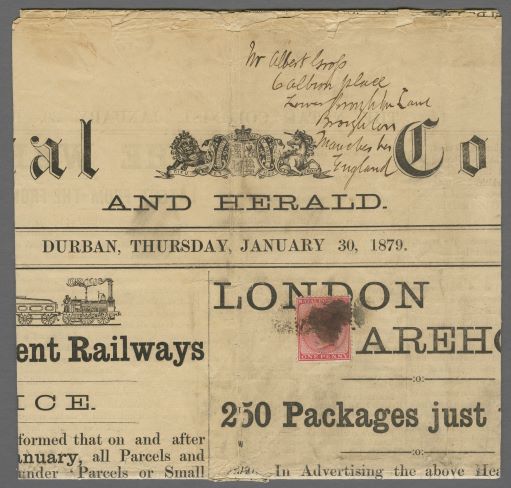
Collecting 19th century Zulu artefacts related to the war is most famously centred on Zulu weapons and shields. From a variety of sources including auctions, collectors, dealers and directly from Zulus living today in KwaZulu-Natal, I slowly began to assemble a collection of 19th century Zulu stabbing spears (Iklwa), throwing spears (Isijula) and knobkerry (Iwisa) clubs. Certainly, the first element that drew my attention in the Anglo-Zulu War toy soldier display all those years ago were the magnificent shields held by the Zulu warriors. The ultimate artefact representing the Zulu side of the war is the regimental war cowhide shield – either the great isihlangu or the slightly smaller umbhumbulozu. The range of Zulu cultural artefacts is vast, including beadwork, pottery, basketry, traditional clothing and more. It is a collecting sphere that crosses into many different materials, mediums, and perspectives. I am still learning and collecting. Taking a cross-category collecting approach to my original passion for the Anglo-Zulu War has changed my life in more ways than I can count. David Beech MBE, the retired head curator of the British Library Philatelic Collections, always promotes the importance of context when writing, speaking, teaching, displaying, or collecting any subject. Mr Beech shared this view with me at our meeting during my first solo trip to the UK in 2009. Every new category of collecting that I ventured into provided context to what I already knew and collected, and with equal importance laid the groundwork for areas still undiscovered in my collecting journey. It is my wish that all collectors have success in their pursuit of knowledge, growing their collections and developing further context to their areas of interest.
So what’s next? Good question. In collaboration with Ian Knight, Lindizwe Ngobese, Nicola Davies (Head of Collections for the Royal Philatelic Society London – RPSL), Chris King RDP, Hon FRPSL (RPSL Past President & Chairman of Philatelic Committee) and others, a public museum exhibition focused on the 1879 Anglo-Zulu War is in the planning stages. As with so many events, the exhibition (to be hosted by the Spear Museum of Philatelic History at the RPSL) has been postponed due to the COVID-19 pandemic. Now tentatively scheduled for mid-2022, the exhibition will be a unique opportunity to come and explore the rich history, heritage, and culture of both sides of the 1879 Anglo Zulu War as seen through hundreds of original artefacts. More information to follow in these pages as the time approaches, so stay tuned!
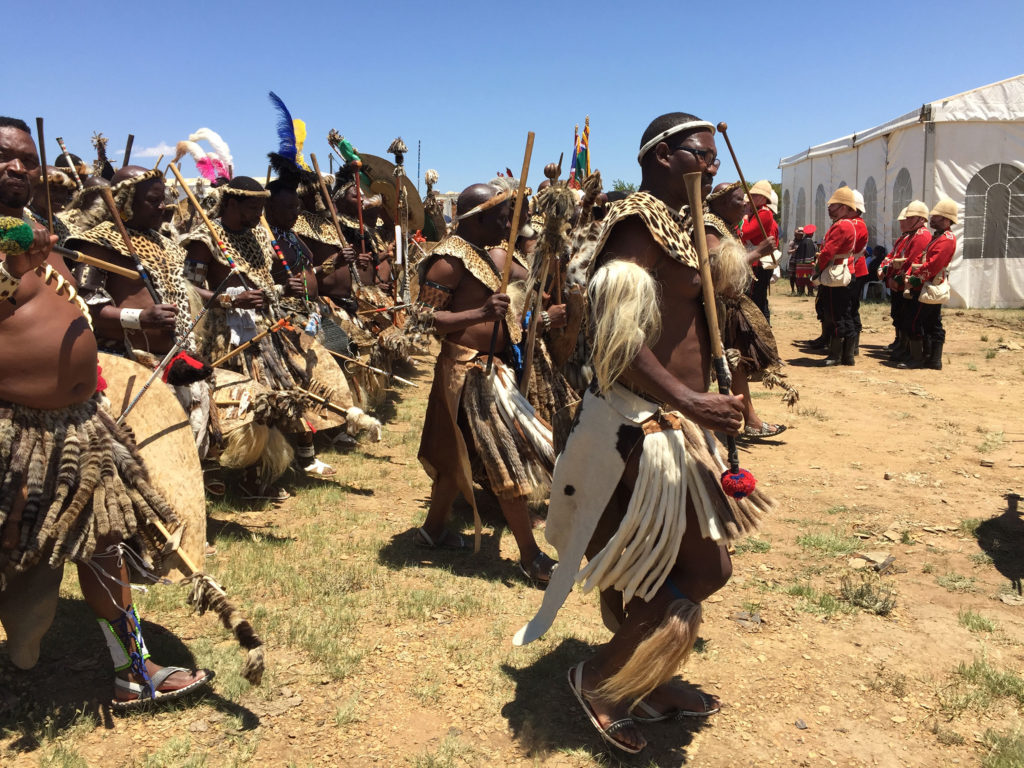
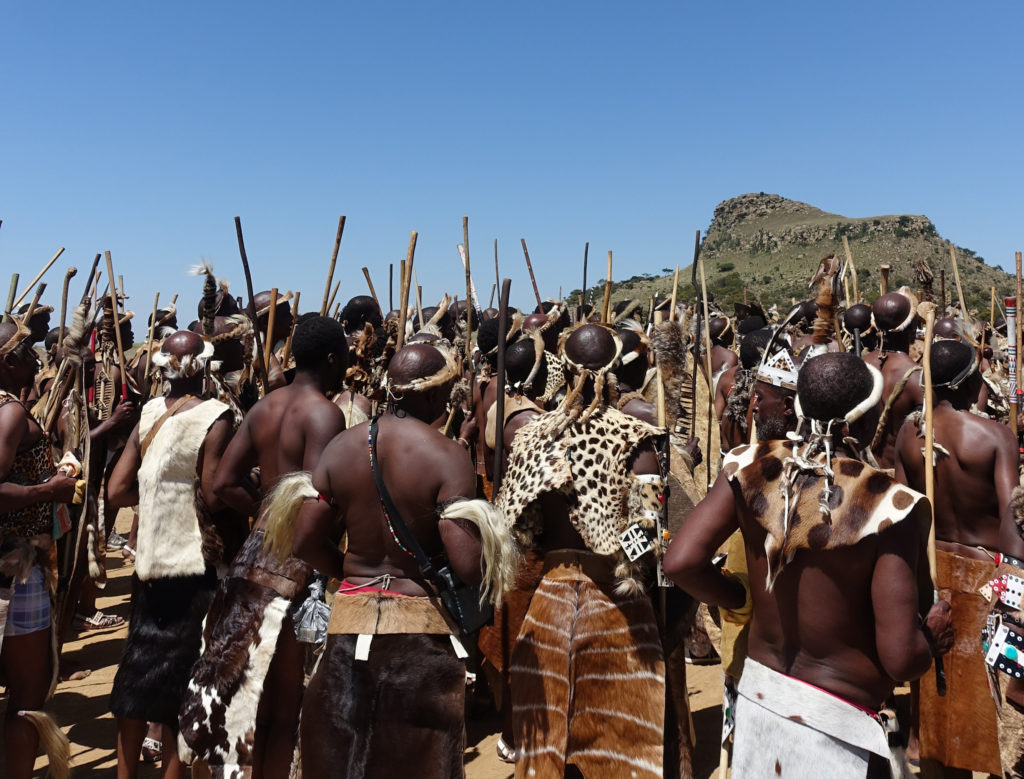
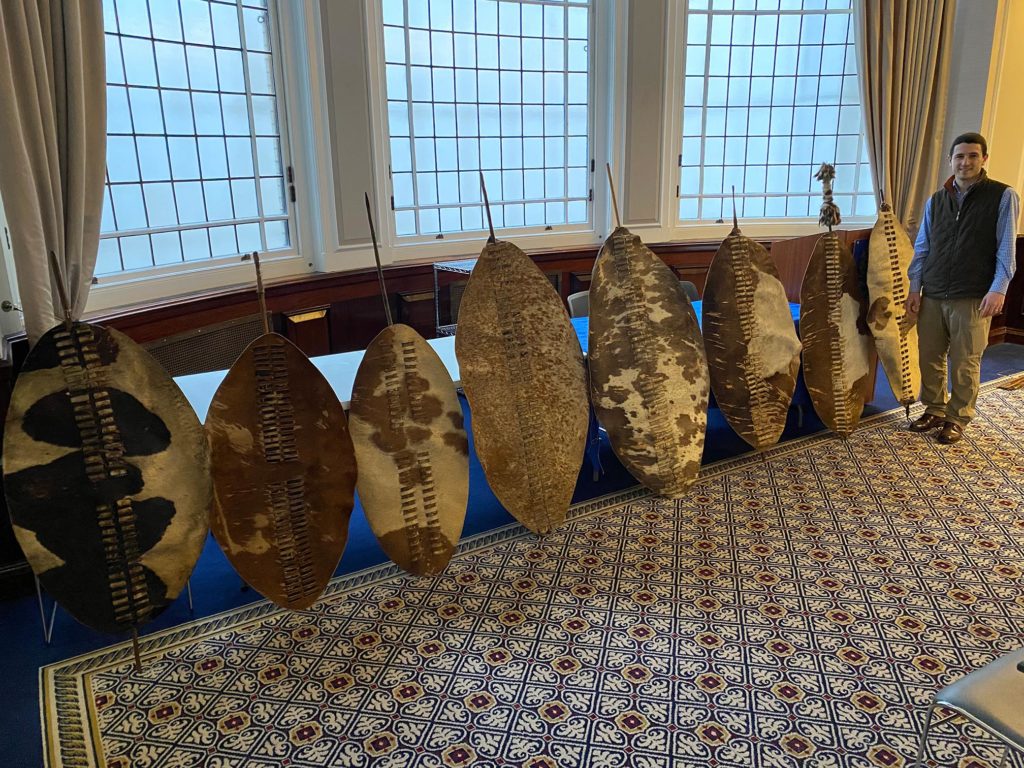
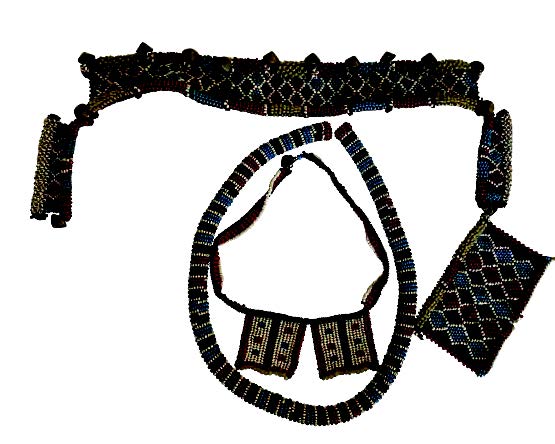

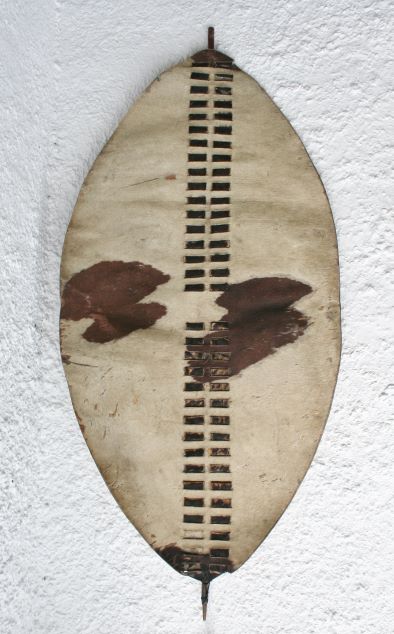
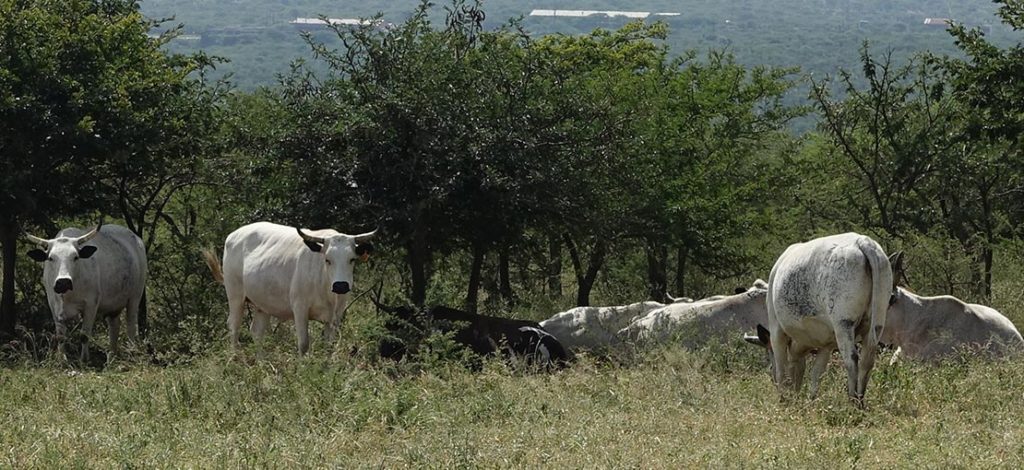
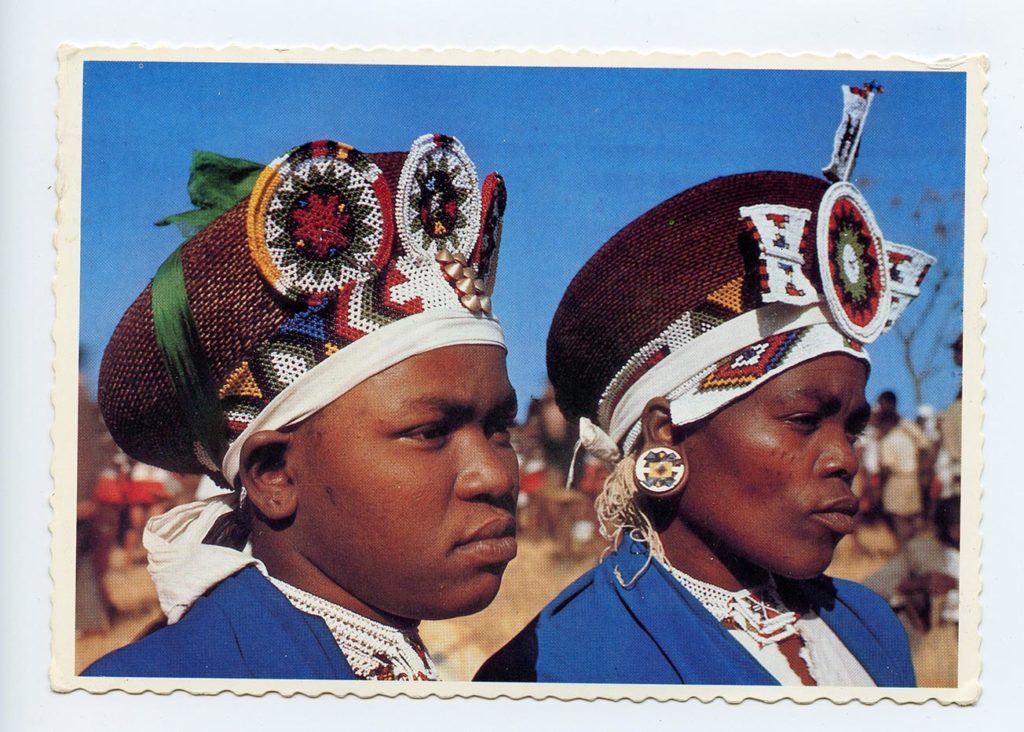
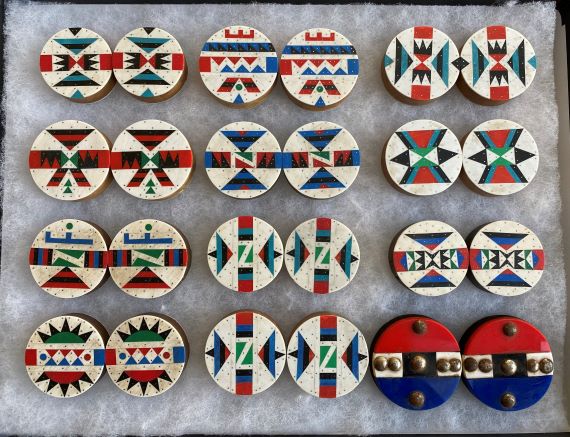
In-Depth Artefact Spotlight #1:
Letter with accompanying envelope written by Colonel Glyn, commanding officer of the Central Invasion column and sent from Rorke’s Drift. Glyn’s column lost half its force at the Battle of iSandlwana and more of his men fought at the Battle of Rorke’s Drift later the same day. Glyn was with an advance force alongside the commanding general of the en-tire invasion, General Chelmsford, and was late to both battles. This letter was sent while Glyn commanded what remained of his original invasion force, in desperate straits camped at Rorke’s Drift in the days following the battles. He is writing to a fellow officer of the 24th and describes both battles along with listing fellow officers who fell at iSandlwana. The cross-hatched writing on the small piece of paper em-phasises the extreme lack of supplies available in the immediate aftermath of the two famous battles. The letter and accompanying envelope combine to represent one of the most import-ant pieces of postal history related to the 1879 Anglo-Zulu War in a private collection.


In-Depth Artefact Spotlight #2:
A white canvas “housewife” folding roll for knife, fork, spoon, cleaning kit etc named in ink to Private W Beckett of the 24th Regiment. This item was given to Private Beckett by the army with his original equip-ment when he started training in 1874. He arrived in Southern Africa in 1877 with the 24th to fight in the final Frontier War and by 22nd January 1879, Beckett was in the hospital at Rorke’s Drift where he took up a defensive position inside. During the battle, Private Beckett was wounded and died the follow-ing morning. This “housewife” kit was sent home with his other per-sonal effects to his next of kin. In July 1997, Beckett’s descendants sold the posthumously awarded campaign medal through Sotheby’s. For close to 120 years, Beckett’s family had stored his medal with this “housewife” kit.
Private Beckett never saw his campaign medal, but he made daily use of this “housewife” kit from his entrance into the 25th Brigade for training in 1874 until the Battle of Rorke’s Drift on 22nd January 1879. This artefact was actually present during the Battle of Rorke’s Drift. The story of Beckett, the provenance, and the elements of the artefact itself are the exact remarkable combination that makes this one of the most significant verifiable Anglo-Zulu War artefacts in private hands.
More details on Private Beckett:
Private J Waters, also of the 1st Bat-talion, and a special orderly in the hospital, recounted the events of that night in The Cambrian (13th June, 1879):
“… Between half past four and five, as near as I can remember, the Zulus came over the hill and I saw about fifty of them form a line in skirmishing orders … They came about twenty yards, and then opened fire on the hospital. Some of them came in and set fire to it. While I was there I took refuge in a cupboard, and Private Beckett, an invalid, came with me. As they were going out I killed many of them, and as I could not stay there long, the place being suffocating, I put on a black cloak which I found in the cupboard, and which must have belonged to Mr Witt (a Reverend who whose mission was based at Rorke’s Drift), and ran out in the long grass and lay down. The Zulus must have thought I was one of their dead comrades, as they were all round about me, and some trod on me. Beckett had gone out half an hour before me, and he, poor fellow, was assegaied right through his stomach, and went into laager the next morning. Dr Reynolds did all he could to save him, but did not succeed … Poor Beckett was buried next morning properly. Round the hospital dead Zulus were piled high.”

Major JRM Chard, VC, also described Beckett’s fate in his account written at the request of Queen Victoria:
“Private Beckett … was badly wounded with assegais in running through the enemy. He managed to get away and conceal himself in the ditch of the Garden, where we found him next morning. The poor fellow was so weak from loss of blood that he could not walk, and he died shortly thereafter.”
Advice for successful cross-category collecting:
Go to the place(s) most connected to your area of interest. Want to collect artefacts related to British military history? Go to Britain to maximise the results of your efforts!
Looking for inspiration on what is available in other collecting categories related to your interest? Look through books on your topic and pay attention to the illustrations. Do you see medals, uniforms, artwork, or something else? These are all new collecting areas to explore further.
Find as many books as possible on your area of interest. Reach out to the books’ authors and talk with them. You never know where the conversations will lead until you do it.
Ask questions. When you find someone through any channel who shares your chosen passion, ask them how they find material for their collection. If/when you encounter a new collecting category you are considering exploring, ask questions about simple details. Let each question and the answer help you build your own base of knowledge.
Reach out to auction firms and dealers that specialise in collecting fields outside of your category. Explain your focus and see if they have anything coming up. Often it takes an outsider’s perspective to give you inspiration for a different way to approach and collect your area of interest. Auction firms that handle many different collecting categories like Spink are particularly useful in this effort.

